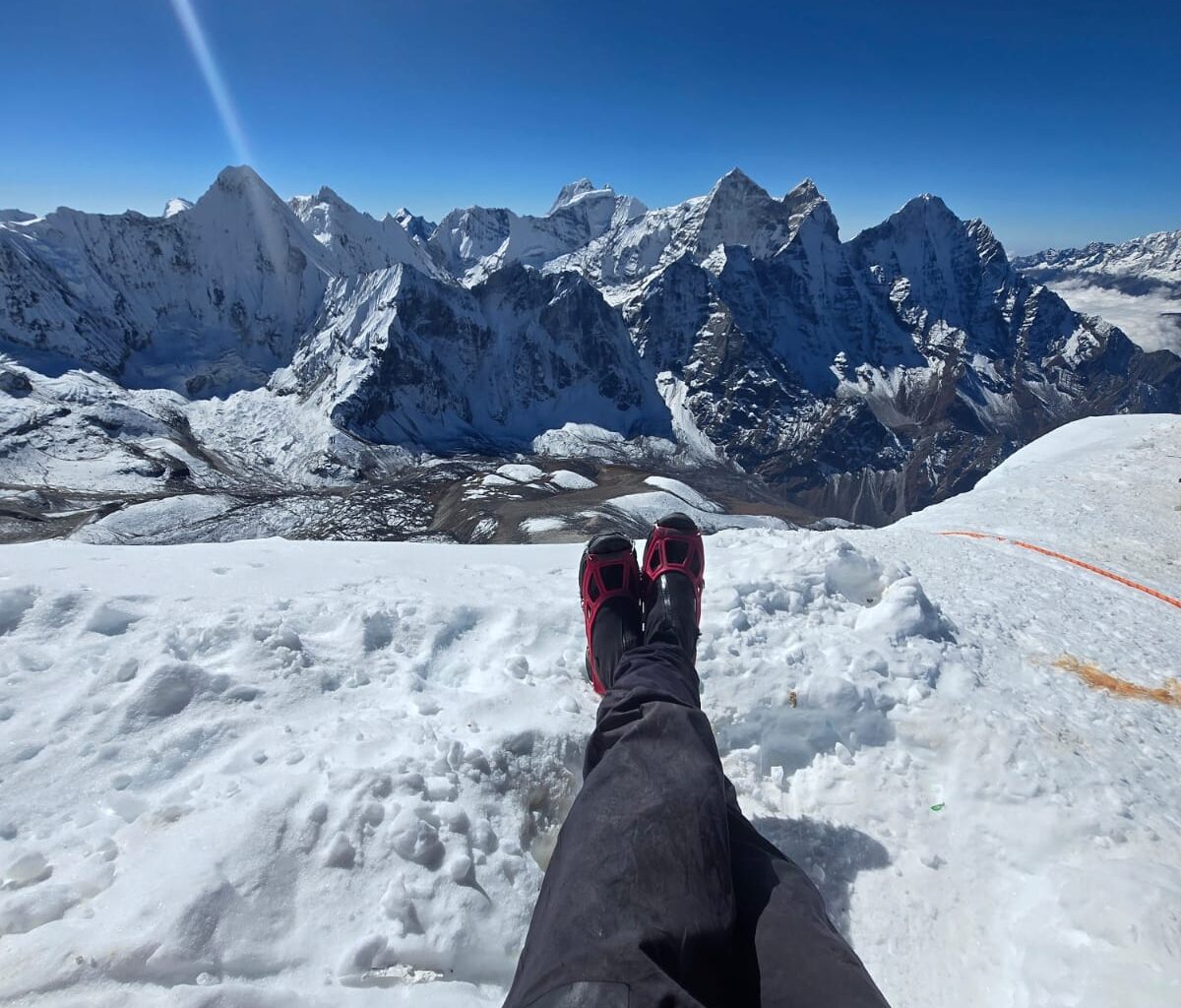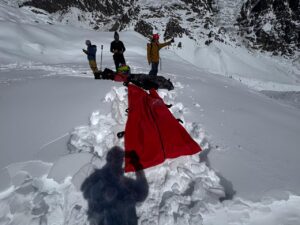Last Sunday, Tyler Andrews and Chris Fisher added FKTs on Ama Dablam to their list of fall successes. Andrews notched the speed record from Base Camp to the summit while Fisher ran from Pangboche village to the summit in record time.
Ama Dablam has seen ascents up different and interesting routes this fall, but the normal Southwest Ridge route remains busy and crowded. This didn’t hamper the American speedsters, who enjoyed perfect weather and conditions on the mountain.
Andrews summited in 3 hours 52 minutes, breaking Ama Dablam’s previous FKT, set last year by Matheo Jacquemoud of France.
Andrews himself had set the previous Pangboche-Ama Dablam summit record of 7h 4 min last year. This time, Fisher completed the 3,000m of ascent and 12km of horizontal distance in 6h 44m. The entire round trip took him 11h 20m.
This is an excellent result, considering that he had a stomach bug just days earlier. He barely had time for one training trip to Camp 1 before starting his run from Pangboche a day and a half later.

Chris Fisher on the summit of Ama Dablam. Photo: Chris Fisher
Final prep
While training jointly, the climbers separated a week before their summit attempts. Fisher remained in Pangboche while Andrews stayed at Ama Dablam’s Base Camp.
For Andrews, the longer route from Pangboche last year was a preparation for this year’s Base Camp-to-summit speed run.
“It is one of the stoutest marks to beat in the Khumbu [after Jacquemoud’s record], and I knew I would have to give all I had,” Andrews told ExplorersWeb. “I was not even sure I could break the record.”
A ‘Mera-thon’
His FKT on Manaslu showed Andrews he was in good shape, and his previous knowledge of the Khumbu Valley allowed him to train efficiently. This season, he also broke his own record on Island Peak.
Andrews and Fisher also made one peculiar FKT: Mera Peak, in one push all the way from Lukla.
“It took us about 16 hours to reach the summit over the distance of a marathon,” Andrews wrote. “Straight out of Lukla, you have to climb 2,000m up and over Zatrwa La to enter the Mera Valley before starting the 3,000m climb to the summit.”
The challenge was far from easy, Andrews recounted, because too few calories and exhaustion began to set in after the first pass and even before reaching Khare, a small village at the foot of Mera Peak. He considered turning around several times but forced some food and water down, continued, and eventually summited.
The Ama Dablam race
Andrews trained in the Khumbu for two to three weeks and then moved to Ama Dablam’s Base Camp. He remained here for a week, checking route conditions, training up to Camp 3, and studying weather forecasts.
“I definitely have felt better this year than in 2023 and more comfortable on the terrain,” Andrews said. “I’ve spent a lot of time training to run at altitude, learning not to freak out at the exposure and all that,” he said.
Andrews said he was more confident despite a close call during the descent of his training trip to Camp 3. He was preparing to rappel down one of the rocky sections when a falling rock the size of a microwave oven flew past his head, missing him by two meters.
“That was scary,” he said. “I decided that would be the last risky climb I’d do this season. Otherwise, I just readjusted my approach and opted for an early start to make sure I had passed that section both on the way up and down before the day got warmer, when there’s more rock falling and more people on the route.”

A look back to Camp 1 on Ama Dablam. Photo: Tyler Andrews
Two tries
Andrews launched his first push on Saturday, November 2 but had to bail at Camp 2.
“I was feeling bad and got too delayed for the record,” he said. “But then afterward, I was so frustrated because there was a big snowstorm forecast for Monday [November 4]. [I] realized that my only option was to attempt the record again the following day. From a training point of view, a big effort the day before a race is what you don’t want to do.”
Andrews focused on just climbing that peak as fast as he could and enjoying himself. But he was surprised to see that his split times were the best he’d done.
Andrews’ timing, stage by stage, was:
BC: Start 03:40 am
BC-C1: 1h 27′ 00″
Break: 3′ 27″ (to put on helmet and harness)
C1-C2: 41′ 45″
C2-C3: 48’40
C3-Summit: 51’31 [3’52’23 total ascent]
Descent: 2h 28′ 07″
6h 20′ 30″ total
Taking risks
As for the traffic, Andrews said he was lucky on the way up. He encountered nearly no one until the final headwall before the summit.
“However, conditions were great, and the section was easy, so passing other climbers was not a problem,” he said. “On the summit, my hopes to break the record on the round trip BC to BC were almost gone, because Jacquemoud is a much more technical climber than I am, and that would be noticeable on the rappels.
“Yet, when I got to Camp 1, I knew I had 40 minutes left to break the record.”
Previous training runs had taken him 48 minutes on that section, but he ran as fast as he could, even taking some risks of falling to maintain his speed. “It was pretty crazy,” he admits. In the end, he bested Jacquemoud’s round trip time of 6h 23 min by three minutes.
Andrews and Fisher are now on their way back to Kathmandu. “My last run in Nepal this year will be the Kathmandu Rim Trail (160km, 11,000m+) on Sunday-Monday of this week,” said Andrews. “That will be all for the season.”






